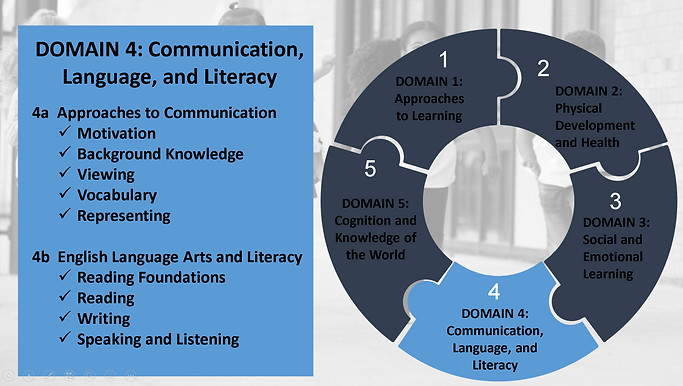top of page
Pre-Kindergarten
DOMAIN 4: Communication, Language, and Literacy


Reading

Writing

Listening

Speaking

Vocabulary
Approaches to Communication
MOTIVATION
Demonstrates motivation to communicate by participating in small or large group activities
BACKGROUND KNOWLEDGE
Demonstrates they are building background knowledge
VIEWING
Demonstrates understanding of what is observed by using relevant vocabulary, making inferences, and drawing conclusions
VOCABULARY
Demonstrates a growing receptive and expressive vocabulary
REPRESENTING
Demonstrates their ability to represent ideas using a variety of methods
English Language Arts and Literacy
READING FOUNDATIONS
Print Concepts
Demonstrates understanding of the organization and basic features of print
Recognizes that words are read from left to right, top to bottom, and page to page
Recognizes that spoken words are represented in written language
Understands that words are separated by spaces in print
Recognizes and names some upper/lowercase letters of the alphabet, especially those in own name
Recognizes that letters are grouped to form words Diferentiates letters from numerals
Identifes front cover and back cover
Phonological Awareness
Demonstrates an emerging understanding of spoken words, syllables, and sounds (phonemes) Begins to recognize and match spoken words that rhyme (e.g., songs, chants, fnger plays)
Begins to recognize individual syllables within spoken words (e.g., cup-cake, base-ball)
Isolates and pronounces the initial sounds (phonemes) in spoken one-syllable words (e.g., the/m/in map)
Phonics and Word Recognition
Demonstrates emergent phonics and word analysis skills
Demonstrates one-to-one letter-sound correspondence by producing the primary sound of some consonants
Fluency
Displays emergent reading behaviors with purpose and understanding
READING
Key Ideas and Details
-
Participates in discussions about a text (e.g., during whole or small group interactive read aloud discussions, during peer sharing, within play scenarios)
-
Retells stories or share information from a text
-
Develops and answers questions about characters, major events, and pieces of information in a text
Craft and Structure
-
Exhibits an interest in learning new vocabulary (e.g., asks questions about unfamiliar words)
-
Interacts with a variety of genres (e.g., storybooks, poems, songs)
-
Describes the role of an author and illustrator
Integration of Knowledge and Ideas
-
Describes the relationship between illustrations and the text (e.g., what person, place, thing or idea in the text an illustration depicts)
-
Makes connections between self, text, and the world (e.g., what is familiar, what does an event/picture/character make them think of, what do they remember)
WRITING
Text Types and Purposes
-
Uses a combination of drawing, dictating, oral expression, and/or emergent writing to state an opinion about a familiar topic in child-centered, authentic, play-based learning
-
Uses a combination of drawing, dictating, oral expression, and/or emergent writing to name a familiar topic and supply information in child-centered, authentic, play-based learning
-
Uses a combination of drawing, dictating, oral expression, and/or emergent writing to narrate an event or events in a sequence
-
Creates a response to a text, author, or personal experience (e.g., dramatization, art work or poem)
Research to Build and Present Knowledge
-
Develops questions and participates in shared research and exploration to answer questions and to build and share knowledge (e.g., record and discuss an experiment of items that float and sink)
-
Engages in a discussion using gathered information from experiences or provided resources (e.g., collect materials from a nature walk; record and discuss what they are)
SPEAKING AND LISTENING
Comprehension and Collaboration
-
Participates in collaborative conversations with diverse peers and adults in small and large groups and during play
-
Follows agreed-upon rules for discussions, including listening to others, taking turns, and staying on topic
-
Participates in conversations through multiple exchanges
-
Considers individual diFferences when communicating with others
-
Interacts with diverse formats and texts (e.g., shared read aloud, video clips, oral storytelling)
-
Identifes the speaker
Presentation of Knowledge and Ideas
-
Describes familiar people, places, things and events
-
Creates a visual display (e.g., drawing, art work, building, writing)
-
Expresses thoughts, feelings, and ideas (e.g., role-playing, music, drawing, art work, building, writing)
Language
-
Demonstrates command of the conventions of academic English grammar and usage when writing or speaking.
-
Demonstrates command of the conventions of academic English capitalization, punctuation, and spelling when writing.
* For the Core Conventions Skills and Core Punctuation and Spelling Skills for Grades P-2, the student is expected to know and be able to use these skills by the end of 2nd grade.
Knowledge of Language
-
Explores and uses new vocabulary in child-centered, authentic, play-based experiences
Vocabulary Acquisition and Use
-
Explores and discusses word relationships and word meanings
-
Sorts common objects into categories (e.g., shapes, foods) for understanding of the concepts the categories represent
-
Demonstrates understanding of frequently occurring words by relating them to their opposites (e.g., hot/cold)
-
Uses words and phrases acquired through language rich experiences, conversations, reading and being read to, responding to texts, and child-centered, play-based experiences
SPEAKING AND LISTENING
REPRESENTING
Demonstrates their ability to represent ideas using a variety of methods
bottom of page